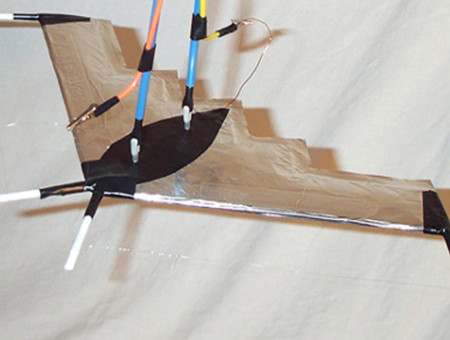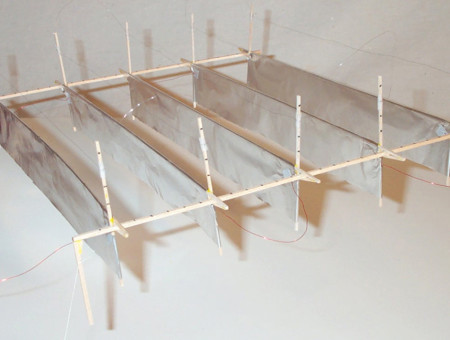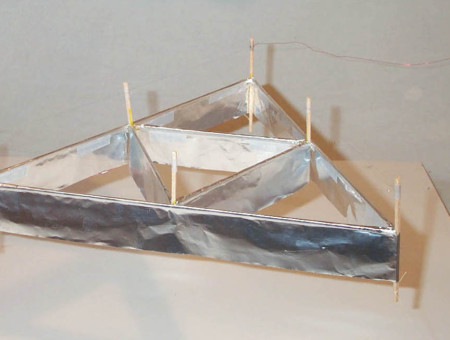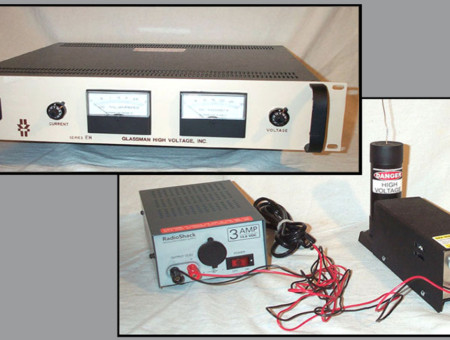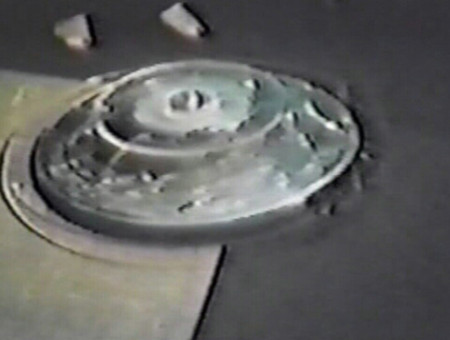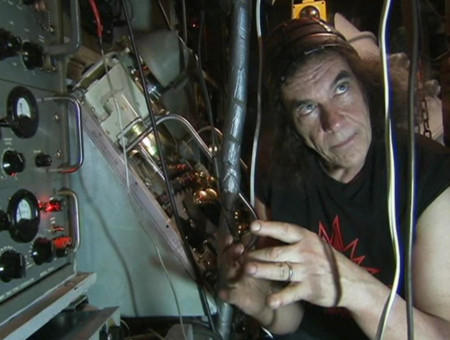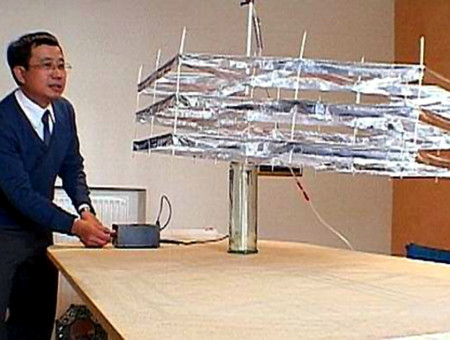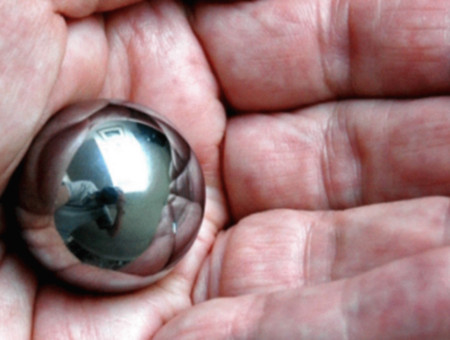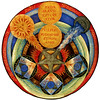Purpose Built Collection of Lifter Designs end.
Electrogravitic Lifter Variants
My Personal Collection of Balsa Wood and Aluminum Foil Electric Kites
The
Original Lifter
Version 1.0
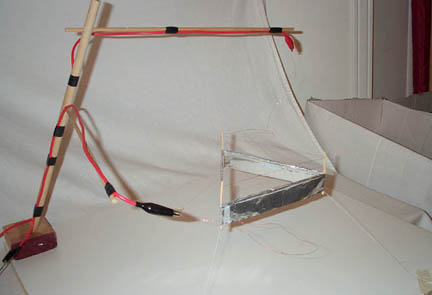
Original Lifter – Version 1.0
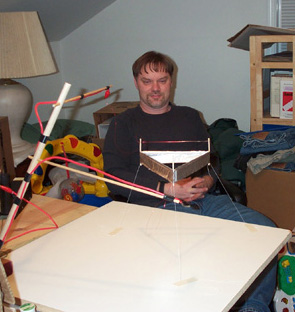
Happy Lifter Pilot
Following the purchase of the Information Unlimited GRA3 DC High Voltage Power Supply, and then carefully constructing this Lifter ver1.0, first flight occurred around 1:15am in my upstairs office, on October 10th, 2002. There were a couple of open minded skeptics in attendance, placing bets on whether this Lifter would sit there and do nothing, or go up in flames, or perhaps, if I was really lucky, actually rise up and fly. Ultimately of course, the big winner was the Lifter itself, launching gracefully up in the air on the very first attempt. Jaws dropped around me, but I just sat and smiled…
The overall Specifications for this basic Version 1 Lifter are as follows:1 Balsa Wood Triangle measuring 200mm per side (2mm balsa strips)
Enameled 22-Gauge Emitter Wire, height set to 30mm (underside stripped of enamel)
35 mm Aluminum Foil Skirt, gently rolled over the top (totaling about 50mm)
Total weight of lifter 7.5 grams
The Launch Pad and Support Gantry were constructed out of press board with white laminate surface (great for holding masking tape!) along with wooden dowels assembled to support the rather heavy 10-Gauge power lead wires. Perhaps the best part of using this odd assemblage of break down parts is I am able to easily load everything into the car, for quick reassembly for demonstrations most anywhere there’s a standard electrical outlet. This made is possible for almost spontaneous, in the moment Lifter demonstrations, which allowed me to have my very own AntiGravity Road Show!

Lifter Corona Discharge
While in operation, this most basic type of Lifter has a few rather interesting qualities. Propelled upwards upon a light ionic breeze, it hovers in the almost silently, producing prodigious amounts of fresh smelling ozone. The first time someone witnesses this unusual phenomenon, they often just stand there watching in total amazement. Yet even more entertaining, when using my original 22-Gauge thick emitter wire, once the room lights are stitched off, they are presented with a stunning blue corona discharge of particles, streaming between wire and top of the foil skirt. Too Cool!
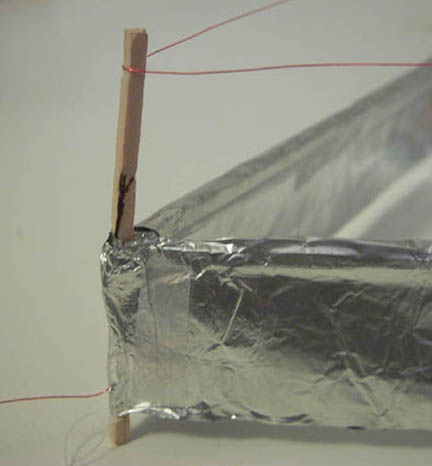
Rough Foil Edges Cause Electrical Arcing
Of course, when experimenting with this kind of high voltage electricity, there will always remain a few unavoidable risks. One such problem commonly encountered by newbie Lifter builders like myself is this tendency for arcing to occur between the emitter wire and the foil, especially at exposed corners. The problem as seen here is that I’ve failed to properly tuck in the cut edges of aluminum foil, thereby providing an easy path for high voltage current to arc across. When the power is switched on, there can be occasional loud cracks as tiny bolts of lightening flash, causing the Lifter to incur rather nasty burn scars on the supporting balsa upright. This provides a good example of learning from experience, as all later Lifter models corrected this problem by carefully trimming and tucking the foil around every exposed corner, sometimes even adding electrical tape for good measure.
Early Test Video of the Original Lifter Version 1.0
Double Triangle Lifter
Version 2.0

Double Triangle Lifter – Version 2.0
The next variation was another fairly standard Lifer design, and this easy to construct Electrogravitic model is known as the Lifter Version 2.0 This particular Lifter is only slightly larger than the original single cell 20cm Version 1.0 model, while incorporating two lifting cells, essentially constructed as one triangle situated within the other.
This Lifter Version 2.0 also employs the standard 2mm strips of balsa wood, but now measuring 30cm on a side, with uprights supporting the emitter wire reaching 90mm tall. Combining an aluminum foil skirt which has been trimmed to a 35mm in length, and using high quality, ultra fine 50 gauge stainless steel emitter wire, this unit weighs in at right around 7 grams. Overall, this Lifter Version 2.0 is generally regarded as an extremely efficient design, obviously having a tremendous amount gravitational buoyancy, primarily due to it’s lightweight construction, and geometric simplicity.
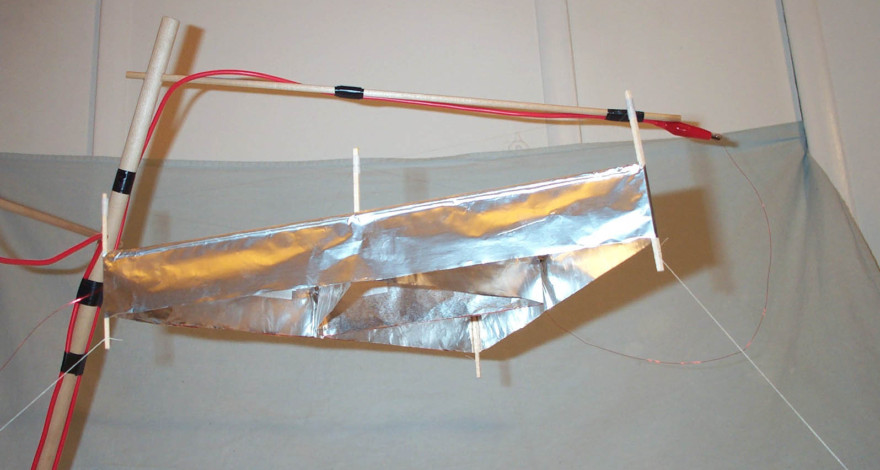
Lifter Version 2.0 As Seen From Below
As this particular model has not given me any problems so far, it has become my most trusted “Lifter Demonstrator.” Since all that is required is to pack up the Power Supply, Launch Pad and Lifter itself, then load everything into the car, where upon my arrival, the assembly of various parts is quick and easy. Then it’s simply ‘Power On!’ to show off this dazzling Electrogravitic effect. To date, this Lifter has yet to disappoint…
Test Video of Double Triangle Lifter Version 2.0
Hexagon Lifter
Version 3.0
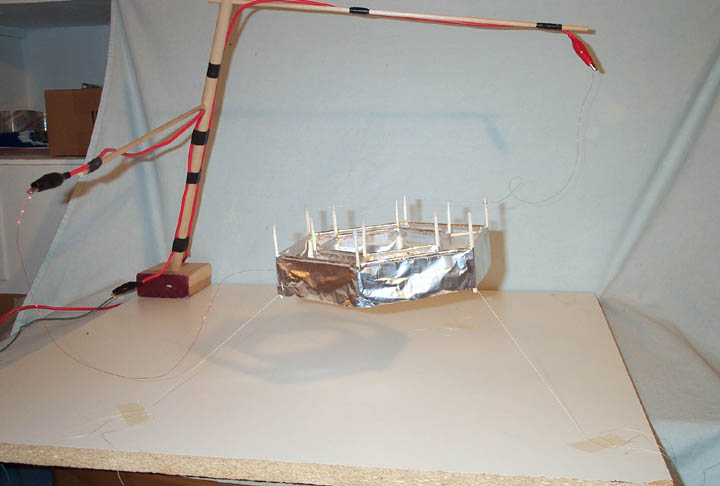
Hex Lifter Version 3.0 in Stable Flight
Presented here are views of a slightly different Lifter of my own design, which I refer to as the Hexagon Lifter. This name is used as this Lifter is comprised of a pair of six sided lifting cells, again placing one slightly smaller lifting cell inside another. With an overall size measuring about 240mm across and 70mm in height, since this unusual Hexagon Lifter variation actually flew, I do consider it something of a success. However, as this model again seems too heavily constructed in relation to overall size, once again, future refinements are in the works. Basically, the lesson is in continuing to learn how to build still lighter, yet always stronger supporting balsa structures.
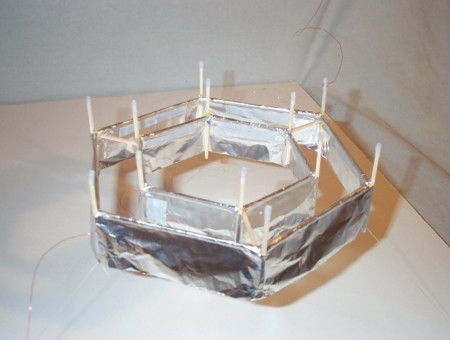
Hexagon Lifter Version 3.0 – Symmetry from Above
Aesthetically speaking, this particular Hexagon Lifer is also my favorite. The careful design of this configuration also succeeded in reducing the severe arcing which would normally occur along the exposed corners. This may be due to in part to improved construction techniques, as well as the wider distribution of electrical current flowing around twice as many more corners. At least, that’s one theory anyway….
When looking at each of these Lifter variants, keep in mind that Ten’s of Thousand of DC KiloVolts of potentially dangerous voltage is being carried through an electrical circuit comprised of nothing more that some rather fine copper or steel wire. In addition, each Lifter must be securely tethered to the base, attached to the base by thread mooring lines with masking tape, restricting all movement to within available flight parameters. Such strict precautions really are necessary when operating these Lifters, as they can launch up very quick off the platform, and then hover almost silently within their exotic high voltage Electrogravitic field. Another consideration is the prodigious production of otherwise fresh smelling Ozone, which is normally considered corrosive to the human throat and lungs, thus it would be best to operate lifters in a well ventilated setting. Just a suggestion….
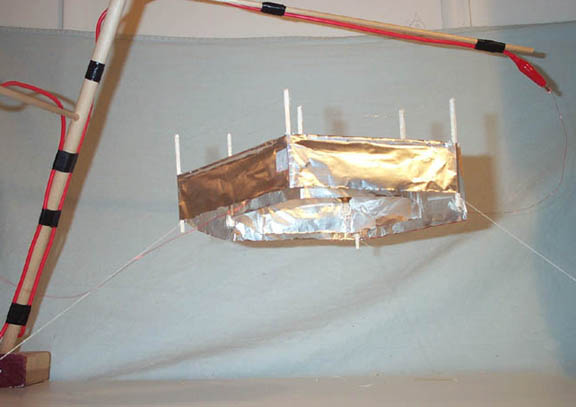
Hexagon Lifter version 3.0 Seen from Below
For your joy and amusement, shared here is my original YouTube 30 second webcam recording, which shows a typically successful experimental flight of this Hexagon Lifter design.
Pleased to mention well over a half million YouTube views recorded for this video.
Triple Hexagon Lifter
Version 4.0
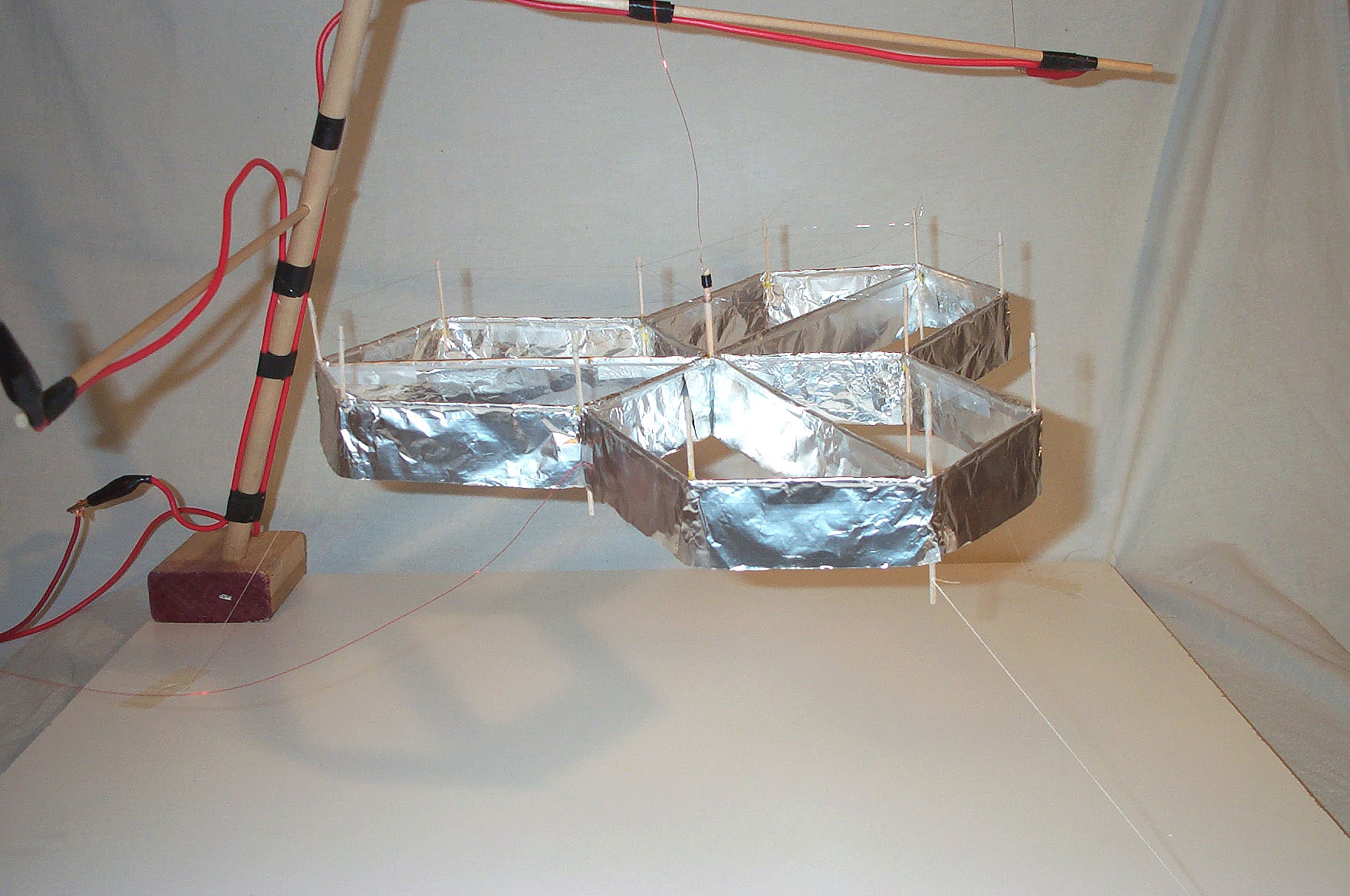
Triple Hexagon Lifter – Version 4.0
It is with some degree of pride I submit my most unique Lifter variation to date. This original design has been designated the Triple Hexagon Lifter, constituting my largest build thus far by a good margin. Incorporating various new structural elements I’ve picked up along the way, making for a satisfactorily functional balsa substructure, which has proven to be genuinely well adapted to this practical application.
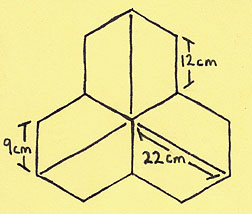
Original Triple Hexagon Design Sketch
This model basically consists of three primary hexagons arranged in a triad formation. Built from an even lighter grade of balsa than previous Lifters, instead of the normal 2mm thick stock, slightly over 1mm stock is used. Although such thin balsa is obviously more delicate to build with, with an appreciable weight savings, it’s worth the added time and effort. Then again, after a Lifter is properly tensioned between foil and wire, even lighter grade of balsa stock can be nearly as strong as the 2mm variety. While under conceptual development, this design appeared well suited for an additional capacitor element to be inserted, bisecting the hexagons. Since this inner element need not serve any structural function, adding this lifting element was a simple matter of rolling an extra wide section of foil over a temporary balsa ‘form’ to create the rounded top, cutting to the correct length, and fitting everything in place with a judicious amount of clear tape. From there, employing a very fine gauge of stainless steel wire, each hexagon was strung with it’s own separate length of emitter wire. This method did require a doubling up of emitter wire above three short lifting elements without seeming ill effect, as well as running the positive high voltage lead wire from the top center upright.
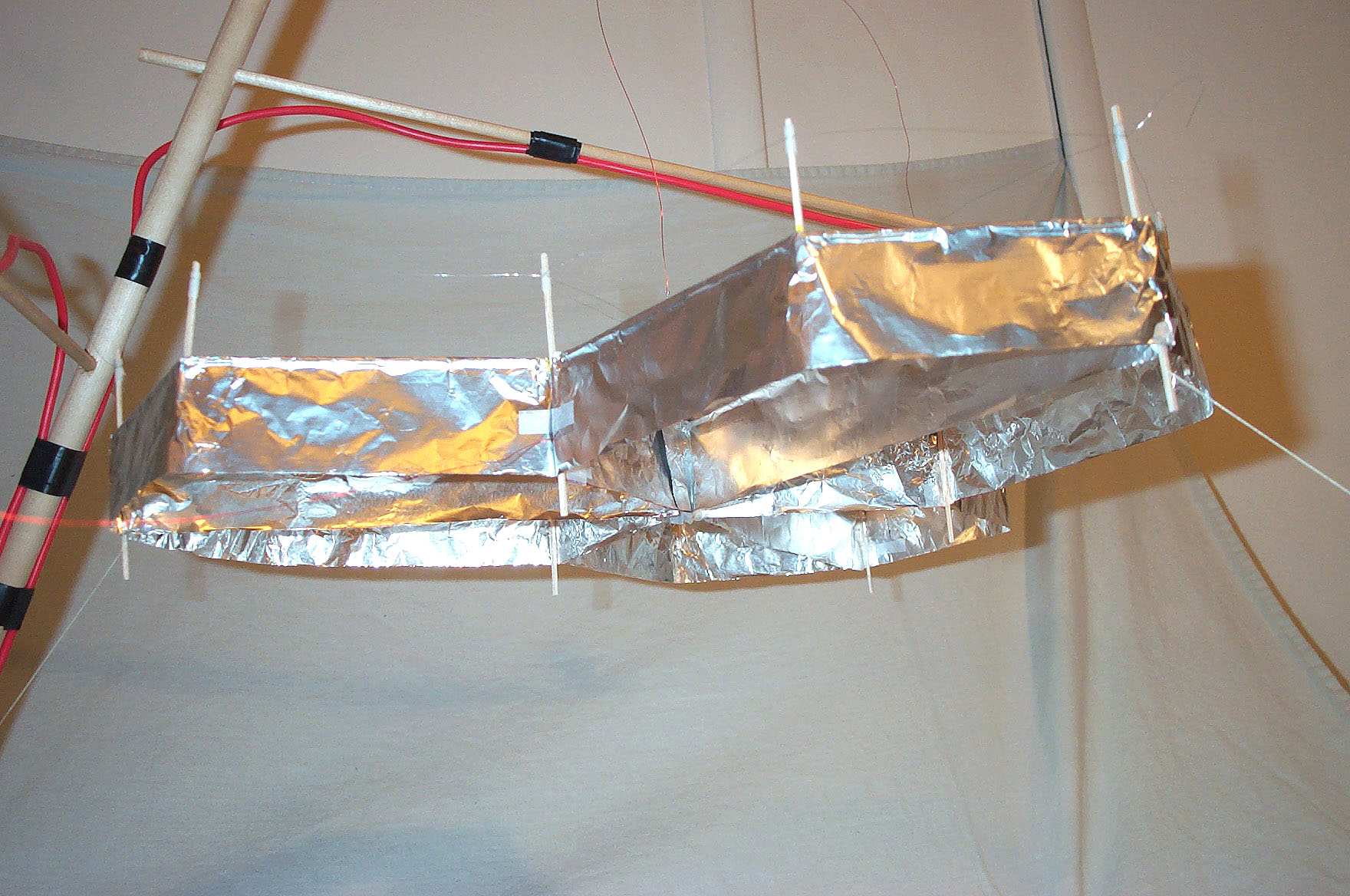
Triple Hexagon Lifter – Version 4.0 – From Below
Of particular interest was a slight complication regarding placement of three wire ends, which essentially can be seen dangling off into nowhere. These were bent back around, pointing down towards the Lifter skirt (barely visible in the above photo) with ends placed about 30mm away from the foil. This turned out to provide real energy savings, reducing approximately 2/10ths of an milliamp in electrical power consumption when operating. The net result of these various design improvements turned out to be the largest and most efficient Lifter yet, measuring a full 40cm across, yet easily lofting at upwards upon just 22KVs, and only 0.8mAmps! You can well imagine future Lifters will be built around this overall successful design!
Now and again, certain events are simply bound to happen over and over… Such as how not too long after creation, the Triple Hexagon Lifter met a most unfortunate fate.
For added amusement, have provided here yet another crummy old webcam video showing an experimental flight of this Triple Hexagon Lifter, check out the action!
Other Alt Think Related Topics...
Carlos Castaneda – In His Own Separate Reality
Enlightening Conversations with a Fictional Yaqui Warrior
Replication of T.T. Brown’s Electrokinetic Apparatus
Converting Electrical Potential into Electrogravitic Propulsion
Lifter Project – Experimental Inquiries into Electrogravity
Probing Intangible Limits of Electrogravitic Knowledge
Lifter Project – Assorted Electrogravitic Examples
Purpose Built Collection of Lifter Designs
The Lifter Project – High Voltage Power Supplies
Glassman EH Series & Info-Unlimited GRA-30
Electrogravitics – History of an Unorthodox Theory
Electrokinetic-Ion Propulsion or Genuine Gravity Modification?
Terence McKenna – True Hallucinations in Paradise
Transcendental Object At The End Of Time
Nikola Tesla – Possibilities Of Electrostatic Generators
Article from Scientific America - March 1934
The John Hutchison Effect
Crystal Batteries, Zero Point Energy and Gravity Modification
Richard Feynman – Early Talk On Nanotechnology
"There's Plenty Of Room At The Bottom"
Jean-Louis Naudin – The Quest For Overunity
Propellantless Propulsion, Cold Fusion, and Magnetic Motors
Electric Universe – Plasma Cosmological Theory
Effects Of Electromagnetism upon Large Scale Cosmic Structures
The Disclosure Project – National Press Club 2001
Military, Intelligence, Government, Corporate and Scientific UFO Witnesses
Wisdom Of The Dream – Episode 3: A World of Dreams
Enduring Influence of Jung's Theories on Modern Life
Wisdom Of The Dream – Episode 2: Inheritance of Dreams
Jung's Archetypes, Symbolism and Collective Unconscious
Wisdom Of The Dream – Episode 1: A Life Of Dreams
Jung's Early Life, Medical Education, and Split from Freud
The Wisdom of the Dream – Life of Carl Jung
Contributions to Consciousness by Swiss Psychologist
Thorium – Safer and Greener Nuclear Energy
Recent Developments in Liquid-Fluoride Thorium Salt Reactors
Chapter 10 – Capture Of Energy By Resonance
The Sea Of Energy In Which The Earth Floats
Chapter 08 – Reactions By Electron Excitation
The Sea Of Energy In Which The Earth Floats


